Donna Semans pulled over at a food cart near a watermelon stand on a dusty turnout to ask directions. She ordered a snowcone topped with diced pickles and powdered Koolaid, a specialty to the Navajo Nation known as a piccadilly. “Not bad,” Semans said, plastic spoon in hand. “When you’re on the road, a pickle really hits the spot.”
She handed a poster in Diné and English to the woman inside that read “Béesó bee’ niiaah dooleeł!” or “Get paid to get out the vote!” With two weeks to Election Day, Semans was traveling around Arizona from gas stations to flea markets to local chapter houses, hoping to get Navajo voters to the polls. She was working with Four Directions, a nonprofit that advocates for voter access in Indian Country. In Arizona, Native voters could be decisive in the outcome of two close Congressional races, one to decide who will replace Sen. Jeff Flake, R, and the other for a House seat in Arizona’s 1st Congressional district.
“We’re trying to make sure Native Americans know it’s their right to vote,” Semans, a member of the Rosebud Sioux Tribe, said. She has worked with voters on the ground for 16 years, traveling to reservations in Nevada and South Dakota from her home in Provo, Utah. “As it is, they don’t trust the government, so they need somebody out there working for them.” The group has been racing to help tribal voters in North Dakota since a state voter ID law went into effect in October, requiring that voters have residential addresses on their IDs. That invalidated the identification of many tribal citizens with ID cards that only showed post office box addresses, and set off accusations by advocates and tribal members that the law was meant to affect tribal voters.
“There are so many more barriers to American elections, versus Navajo elections,” added her colleague and traveling companion, Jennifer Crow, a member of the Choctaw Nation. “And the requirements keep changing.”
The Navajo Nation is the largest reservation in the United States and covers swaths of Utah, Arizona and New Mexico. Like many Indigenous communities, its citizens face a gauntlet of voting obstacles, from long trips to polling places, to a lack of language assistance and restrictive identification requirements, and an entrenched distrust of federal and state elections. Now, to participate in the democratic system, Navajo voters may face an additional roadblock: compliance with the Americans with Disabilities Act (ADA).
A civil rights law that prohibits discrimination against individuals with disabilities, the ADA requires that state and local governments ensure people with disabilities have a full and equal opportunity to vote. Though the ADA is a federal law and thus does not apply to tribal nations, it does apply to polling places operated by the county. In 2016, a Department of Justice survey found that 30 of 31 voting locations they looked at in sprawling Coconino County, Arizona, violated the terms of the ADA. According to the county, most polling places lacked van-accessible parking, adequate signage, and had unpaved or uneven sidewalks and walkways. A subsequent, more expansive survey of all voting locations in the county, 65 at the time, found that 46 of those 65 polling places required remediation. Those violations led to a settlement between Coconino and the DOJ in May, under which the county was required to start remediating its polling places “in time for its next election” and to ensure that they are all accessible for people with disabilities before the November 2020 elections.
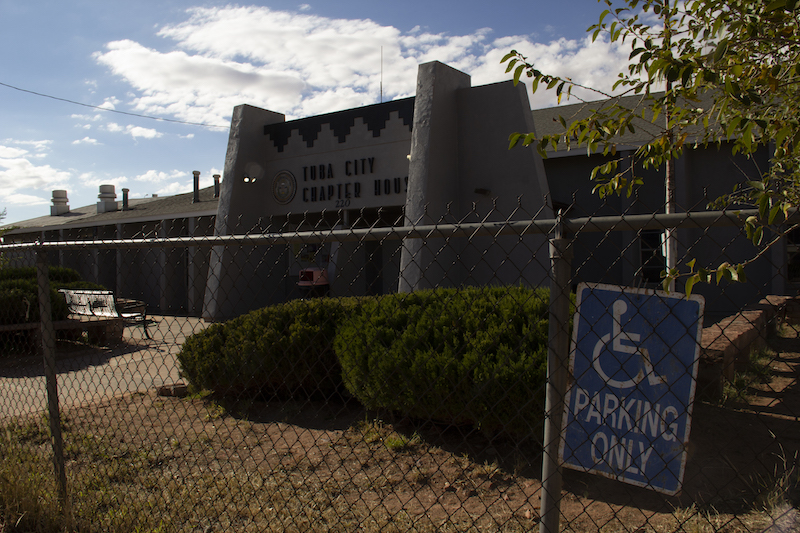
A handicap parking sign hangs on a chain link fence at Tuba City Chapter House in Coconino County, Arizona.Image: Jolene Nenibah Yazzie/The Investigative Fund
This summer, before the August primaries, Coconino County decided five polling locations could not be made accessible with temporary fixes such as portable ramps and signage, and would need to be moved. Alternate polling sites were selected in and around the city of Flagstaff. The closest one moved half a mile from its original location to a community center, the farthest to a church 13.5 miles away from its original location in the Arizona Snowbowl ski lodge. Coconino County recorder Patty Hansen says the county notifies households of the change in location by mailing sample ballots with information of the voter’s polling location. Hansen’s office has also put up signs at old locations to direct voters and sent out media alerts with details on how voters can get more information about their polling places.
The settlement could mean more access for voters with disabilities, but voting advocates and attorneys worry that it could hinder the opening of polling locations and early voting sites in Indian Country in the future. Coconino County boasts a Native population of more than 27 percent and includes territories of the Navajo Nation and four other tribal nations. The five polling places that were moved serve a population of 835 Indigenous people.
Hoskie Benally, Jr., president of the Navajo Nation Advisory Council on Disability, said that he sees federal involvement as a good thing. “I don’t think anything would have happened if they didn’t get involved. The Navajo Nation itself wasn’t addressing it.” Benally, a Navajo citizen who has a visual impairment, gets assistance from his wife to help him navigate challenges such as unpaved parking lots and uneven sidewalks on Election Day. She also fills out the ballot for him when audio ballots are not available. “We want to be like everybody else and have the opportunity to get into the polling site with the privacy that we need,” said Benally.
But to some observers, the relocation of the polling sites just months before highly contested midterms raises questions as to whether or not the DOJ’s efforts to enforce ADA compliance could be used as part of a larger voter suppression strategy. A 2013 Supreme Court decision, Shelby County v. Holder, which revoked the Voting Rights Act requirement that counties or states with a history of discrimination must have all polling changes pre-cleared by the Department of Justice, has added to those fears. Arizona was one of those states — and so was Georgia, where this August, the Randolph County elections board considered closing 75 percent of its polling stations, citing ADA compliance. Randolph County is 61 percent African American. Public outrage halted the closures.
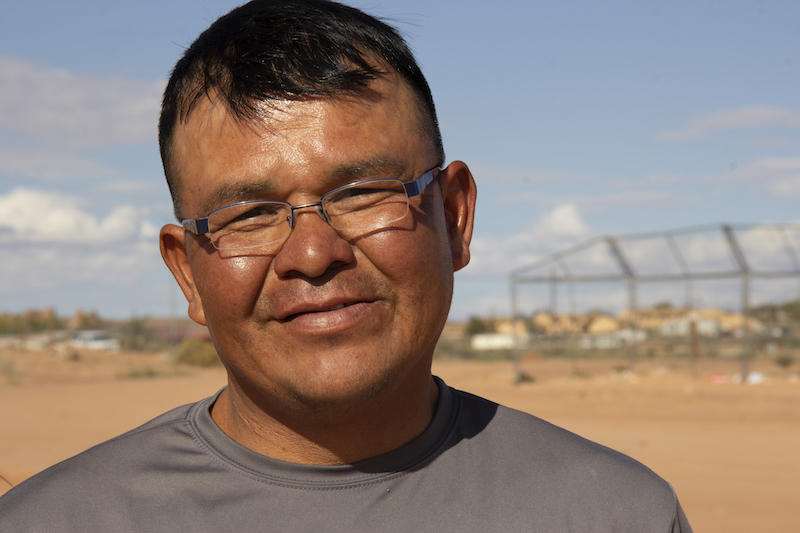
Vernon Tsinigine, an early voter, at a flea market in Tuba City, Arizona.Image: Jolene Nenibah Yazzie/The Investigative Fund
“We’ve seen a number of voter suppression tactics — closing polling places, purging voter rolls, strict voter ID laws, et cetera — primarily aimed at disenfranchising people of color and people with disabilities,” said Zach Baldwin, director of outreach for the advocacy group American Association of People with Disabilities, describing the reports from Georgia as “another blatant attempt at voter suppression.”
In September, ten senators, including the vice chairman of the Senate Indian Affairs Committee, Tom Udall, D-New Mexico., sent a letter to the DOJ asking how the agency would ensure that one civil rights law, the ADA, doesn’t violate another, the Voting Rights Act, and what kind of oversight the agency would have over counties when implementing settlements. The DOJ has still not responded, according to Senate staffers for Udall and another signatory, Sen. Amy Klobuchar, D-Minn..
“It is alarming that, with mere days to go before a major election, the Department of Justice continues to ignore our legitimate congressional inquiries about the use of the Americans with Disabilities Act as a pretext to close polling locations,” Udall said. “I am particularly concerned about how these closures may affect Native Americans on tribal lands seeking to exercise their right to the franchise.”
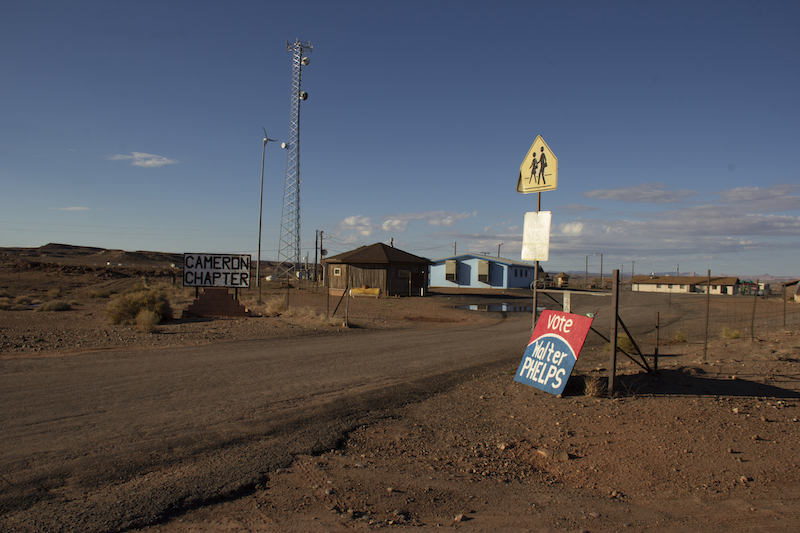
A paved road leads to the Meeting Hall where Cameron residents go to vote for the Navajo Nation election. The road ends at the Cameron Senior Center where Coconino County voting takes place.Image: Jolene Nenibah Yazzie/The Investigative Fund
Patty Hansen has worked in election administration for 30 years, and been with the Coconino County recorder’s office for the last 15. Growing up in a segregated part of Texas informed her desire to work as an election official, she explained. “Native Americans have had to fight so hard to get the right to vote. It’s shameful, our history,” Hansen said, her Texan twang growing more pronounced. “And so we need to correct that and make sure that doesn’t happen again.” Hansen is also concerned about the North Dakota ID law and how similar efforts may spread to Arizona because of its history of discriminatory laws and the use of PO boxes as mailing addresses on the reservation and in rural areas. “We’d have to go to court. It would have a huge impact on us.”
Coconino County is largely rural and home to the Grand Canyon, which presents its own challenges to Native American voter access. This year, for example, a flood drastically affected the Havasupai Tribe, a nation of around 600 people who live at the bottom of the canyon in Arizona. The county mailed ballots out for the primaries, but none came back. The Havasupai, though, have one of two polling locales on tribal lands within the county that are ADA compliant. The building is relatively new, and there is no parking lot because all travel is by foot, horse or helicopter. For elections, a county employee from Flagstaff drives 160 miles to reach the Hualapai Hilltop trail at the Grand Canyon that he hikes eight miles down to the town of Supai. The next day, carrying the ballots, he retraces his steps eight miles up and then drives 160 miles back to Flagstaff.
The Navajo Nation is vast. One can easily go a few hours between some towns, and much of it unpaved. The parking lots and neighborhood streets are a reddish dirt, and rain can create mud that requires a four-wheel-drive vehicle. The locations chosen as polling places were mostly built before the ADA passed in 1990. The DOJ settlement doesn’t come with federal funds attached to it, and neither the Nation nor the county are sure yet where that money will come from. Thus, buildings that temporarily become polling stations on Election Day, like churches and chapter houses, will have to be modified. Otherwise, the county will have to choose a new location, which Hansen says they want to avoid as there are hardly any that would fulfill the ADA requirements. “There’s just no alternatives,” she said.
In Tonalea, a small town of around 550 people on the Nation, Coconino County voter and former Navajo Nation council candidate Darrell Marks said from his experience that elders — a population that could benefit from ADA compliance — are the most active in elections, primarily for in-person Election Day voting.
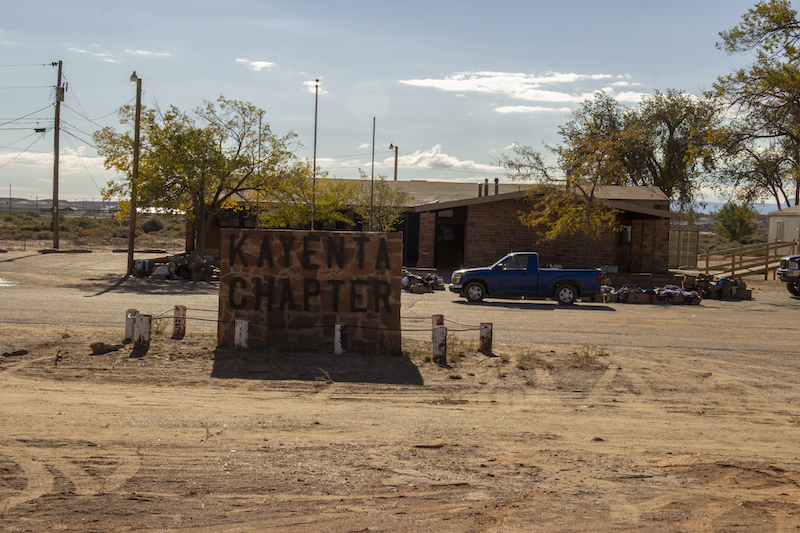
Kayenta Chapter in October 2018.Image: Jolene Nenibah Yazzie/The Investigative Fund
“My elders can recall a time when they weren’t eligible to vote,” Marks said. “An example they would give me is, ‘If you vote for this bilagáana, this white person, in Washington, they get to determine what we do as a people.’” Citizens of the 22 tribal nations in the state were unable to vote until 1948, and after that were hindered by English literacy tests, redistricting that diluted voting power and restrictive voter ID laws. The Voting Rights Act of 1965 had “a significant impact” on minority voters in Arizona’s 15 counties; voter registration increased 165 percent from 1972 to 1980 in Coconino County alone.
The DOJ brought 22 cases in 30 years over discriminatory practices under the preclearance section of the Voting Rights Act for disenfranchising Native American voters in Arizona, most often against the three counties that the Navajo Nation spans: Apache, Navajo and Coconino. But within three years of the Supreme Court’s Shelby decision, Arizona closed 212 polling places statewide, according to a 2016 analysis by the Leadership Council on Civil and Human Rights. “By sheer numbers and scale,” the report read, “Arizona is the leading closer of polling places in the aftermath of Shelby.”
“What’s happened since preclearance was struck down is [states are] passing laws that are discriminatory,” said Hansen, who does not intend to close polling stations on tribal lands. “It’s really sad, because voting’s powerful. If it wasn’t so powerful, why have they kept so many people from doing it in our history?”
The last time Jennifer Crow, of Four Directions, worked in the Navajo Nation was in 2010, to assist voters after a strict voter ID law was implemented in Arizona that required residents to show photo IDs before participating in federal and state elections. This limited elders without birth certificates or IDs. A review of reservation turnout numbers by precinct from election years 2004 to 2014 showed that 2010 had the lowest turnout overall: Between 22 and 59 percent at different locations. “The environment is one of voter rejection,” Crow said.
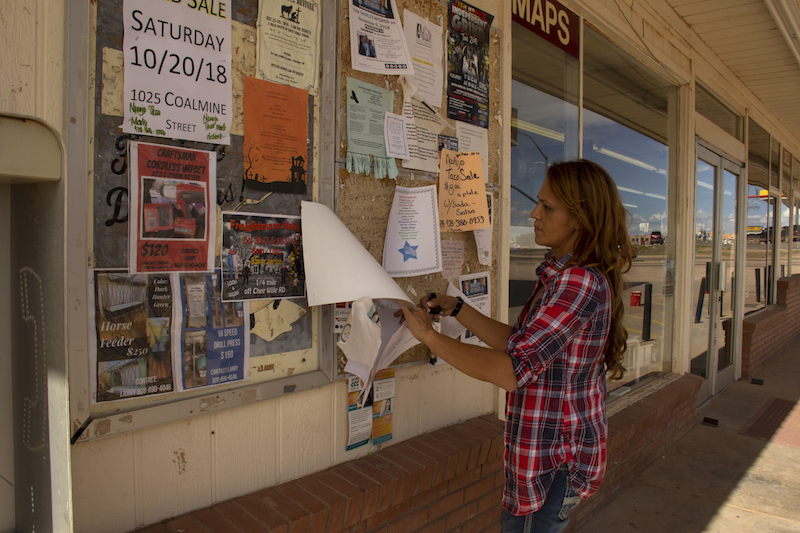
Donna Semans, director of Four Directions, pins a flyer to a bulletin board outside the Tuba City Express gas station in Tuba City, Arizona.Image: Jolene Nenibah Yazzie/The Investigative Fund
When Marks came of voting age, elders impressed on him the importance of electing the right person to advocate for them. “They’re the ones that cut the checks,” his grandmother told him of Congressional politicians. “They’re the ones who determine how much money our tribe gets to build the houses or to repair the water well we get water from.”
In Arizona, two Congressional races could shift power in the U.S. House and Senate between Republicans and Democrats. Martha McSally, R, and Kyrsten Sinema, D, are within just a few polling points of each other to fill the seat left open by Sen. Jeff Flake, R, who is not running for re-election at the end of his term. In the House, incumbent Rep. Tom O’Halleran, D, is in a close race for Arizona’s 1st Congressional District with Republican challenger Wendy Rogers. All over the Navajo Nation, blue O’Halleran signs dot the landscape. Indigenous people in the district, who make up more than 22 percent of the population, are heavily Democratic. In 2016, Hillary Clinton carried the county, despite Arizona overall going to Donald Trump. Native Americans eligible to vote in Arizona make up 5 percent of the population, according to the National Congress of American Indians, which means they could be a major voting bloc — if they know where to vote.
In Mohave County, which borders Coconino to the west, officials on the 121,000-acre Kaibab Paiute Reservation last year requested an in-person polling location in their territory. In a July email, the director of county elections told a staffer with the Inter Tribal Council of Arizona, a consortium of tribal governments that works on policies affecting Indian Country, that he had made a site visit and found the site wasn’t ADA compliant. The reservation has no in-person voting sites; the closest is more than 20 miles away, off reservation, in majority-white Colorado City.
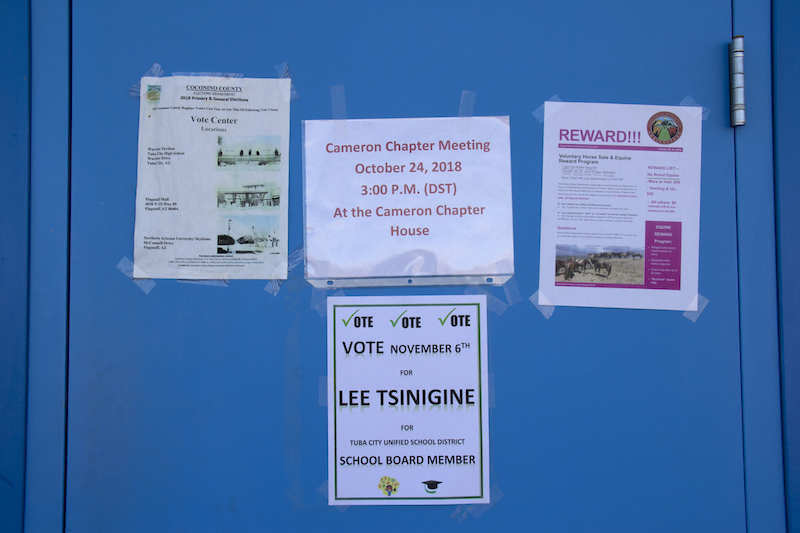
Flyers taped to a door at the Meeting Hall in Cameron, Arizona, where Navajo citizens vote in Navajo Nation elections. Image: Jolene Nenibah Yazzie/The Investigative Fund
“The other counties that cover the Navajo Nation, those clerks are nervous about getting similar suits filed against them,” said Katherine Belzowski, an attorney at the Navajo Nation’s Department of Justice. She points to a request sent from the Navajo Nation to Coconino County in August for three new early voting locations in chapter houses, centers at the heart of many Navajo communities. The county declined, writing in a letter that the ADA compliance agreement signed with the Department of Justice required all locations “established after the effective date of the agreement completely comply with the accessibility standards of the Americans with Disabilities Act.” (Hansen said she wouldn’t have put early voting locations at the proposed locations anyway, because so few early voters came out when they did a trial run during the 2016 election.)
“I think [concern about federal enforcement is] chilling the consideration of opening other early voting locations,” said Alex Gulotta, Arizona state director for All Voting is Local, a national, nonpartisan voting rights group.
The alternatives for those unable to physically get into polling sites such as the community center and the Arizona Snowbowl lodge include mail-in ballots or curbside voting, where a poll worker comes out to give a voter a ballot to fill out in the car. But those options come with their own set of struggles: Curbside voting doesn’t provide the privacy of a voting booth, something civil rights advocates say should be fundamental when voting. Vote-by-mail, on the other hand, is unreliable in Indian Country where rural mail service is nearly nonexistent, and translated election materials are not always available.
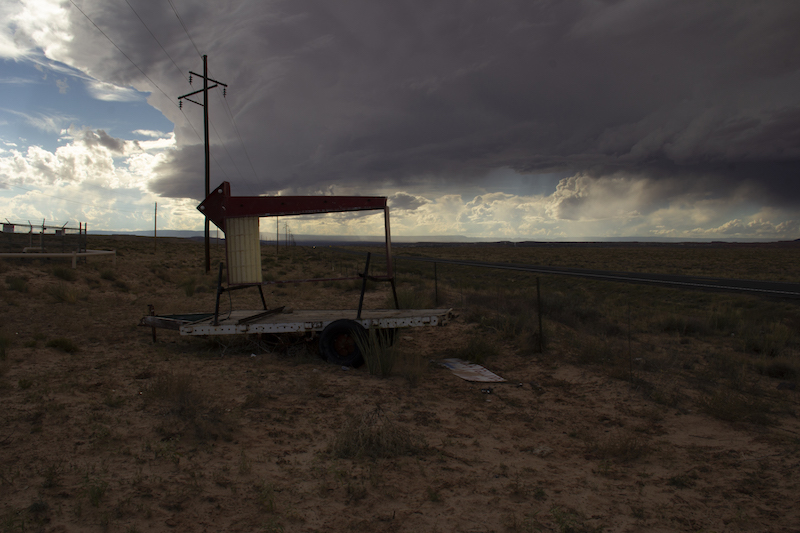
An old sign on Navajo Trail Road outside Tuba City, Arizona.Image: Jolene Nenibah Yazzie/The Investigative Fund
“We have to have realistic options when it comes to Indian Country,” said Patty Ferguson-Bohnee, director of Arizona State University’s Indian Law Program. “It will be very difficult to permanently modify all of the polling places in Indian Country, so what are the options for those individuals?”
Ferguson-Bohnee stresses the importance of coming up with viable solutions that will work for Navajo citizens, which would likely mean incorporating some, but not all, ADA requirements. But in a community where just 23 percent of the roadways are paved and 70 percent of those roads are in poor condition, doing a complete overhaul of polling places funded by the Navajo Nation is unlikely.
“There has to be some kind of balance between voter access and meeting ADA requirements,” Ferguson-Bohnee, a member of the Pointe-au-Chien Indian tribe, said. “It would be helpful if [the DOJ] spoke with the tribe and knew what the realities are on the ground.”
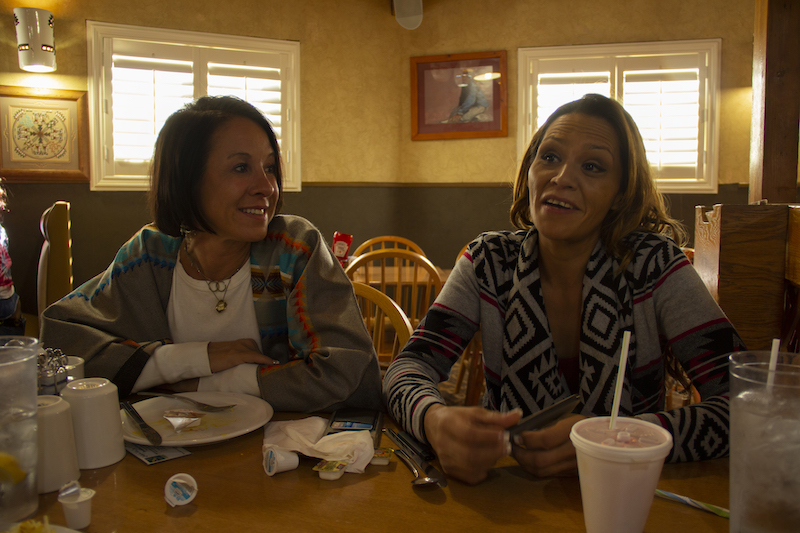
Jennifer Crow (left) looks to Donna Semans, director of Four Directions, at Hogan Restaurant in Tuba City, Arizona.Image: Jolene Nenibah Yazzie/The Investigative Fund
In a dusty lot not far from Tuba City, Arizona’s downtown, Donna Semans approached flea market vendors, fliers in hand. “Did you guys hear about the North Dakota thing?” she asked some people in line at a frybread stand. It was a question she used often, and the person inevitably nodded. “That’s our organization. We’re up there fighting for them. Right now we’re promoting early voting.” Few were interested in engaging, giving short replies at the most, but always taking the flyer. If Semans was bothered, she didn’t show it. Instead, she moved on to the next booth.
Note: This story has been corrected to reflect that Democratic Senator Tom Udall represents the state of New Mexico, not Arizona.
This article was reported in collaboration with The Investigative Fund at The Nation Institute, now known as Type Investigations.